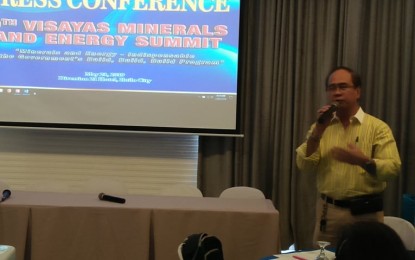
INTENSIFIED MONITORING. Mines and Geosciences Bureau (MGB) Regional Director for Western Visayas Roger A. de Dios announces plans to intensify monitoring of mineral extraction in the region during a press conference in Iloilo City on Thursday (May 23, 2019). De Dios said the MGB has observed unreported volume of extracted minerals in the region. (PNA photo by PGLena)
ILOILO CITY -- Mines and Geosciences Bureau (MGB) in Region 6 (Western Visayas) has intensified its monitoring of industrial, sand and gravel extraction after observing the unreported extraction of mineral volume.
MGB-6 Regional Director Roger A. de Dios said the construction in Western Visayas boomed based on the Philippine Statistics Authority (PSA) data but the mining sector posted negative growth last year.
The PSA data showed that the mining and quarrying growth significantly dropped from 36.7 percent in 2017 to negative 1.5 percent in 2018 while construction grew by 14.3 percent in 2018, a big leap from 4.3 percent growth posted in the preceding year.
“That’s why it was really proven in the PSA report in the corresponding contribution of minerals in terms of RGDP (Regional Gross Domestic Product). It did not jive with the increase in construction activities in the region. For me it does not even reach 50 percent, I’m very sure of that,” De Dios said in a press conference on Thursday, a day before the 9th Visayas Mineral and Energy Summit kick off here.
He said this meant “there are those unreported extraction of mineral resources in Western Visayas”.
To address the problem, he said the MGB has changed its policy by doubling the volume of extracted mineral.
“We require applicants now to increase their volume to a maximum of around 20,000 cubic meters. The 10,000 allowed by local government units concerned is not viable for industrial operations,” he said.
During their monitoring, De Dios said they found one permittee whose stock pile reaches to around 30,000 cubic meters when it was only allowed to have 3,000 cubic meters volume. The permittee has been penalized.
He said the MGB team also discovered permittees whose allowed volume of extraction is only 1,000 cubic meters for one year.
The MGB also monitored deliveries without date if not tampered date and volume that was not properly indicated.
With this, he urged the local government units (LGUs) to “conduct or establish checkpoints and create task forces in order to properly monitor the transport and delivery of aggregates, including sand and gravel”.
The LGUs issue industrial, sand and gravel permits for extraction that covers less than five hectares.
He also said part of the change in policy is the conduct of training with the end goal of minimizing pilferage and misreporting.
De Dios said the government lost billions of pesos in taxes due to failure of the permittees to declare the actual volume of their extracted minerals.
Meanwhile, the mining and energy summit that will gather mining engineers from Visayas will formally open on Friday with Environment Secretary Roy Cimatu as keynote speaker.
The summit anchors on the theme: “Minerals and Energy- Indispensable in the Government’s Build, Build, Build Program”. (PNA)
